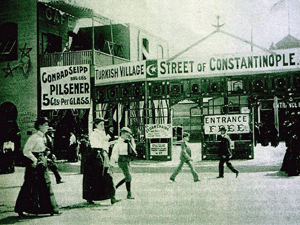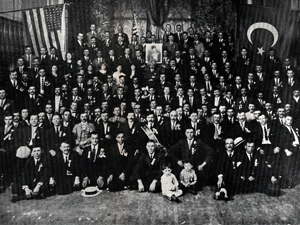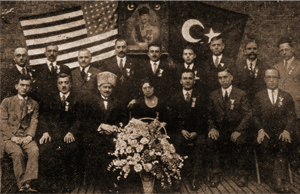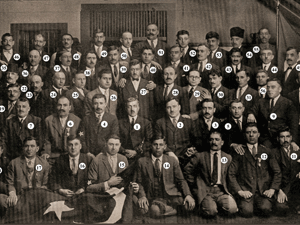First Turks in the U.S.
- Written by Admin TOA
- Published in Interesting Facts
They started the long track to United States by leaving their homeland; most of them were from Harput (Elazığ). 1.2 million Ottoman citizens immigrated to United States between 1860 and 1921. 200,000 of them were from a Turkish and Muslim heritage and most of them returned back to their motherland since.
Researcher Sedat İşci and Historian Prof. John Grabowski are tracking the grandchildren of the ones stayed behind. The interesting story of The First Turks in America will be immortalized at a museum to be established in Turkey.

Turkish Village introducing Ottoman culture to Chicago in 1893.
THE FIRST TURKS IN AMERICA
1893, the 400th anniversary of America’s discovery also coincides with Chicago’s streets getting acquainted with the architecture, art, and cuisine of the Ottomans for the very first time. With the support of the American government, Sultan Abdulhamid II established a Turkish Village in Chicago with the hopes of introducing Ottoman culture to Americans. Even Sultan Abdulhamid II, who had special interest in carpentry, joined the exhibition himself with one of his own artwork and won the first prize! Turks who bought tickets to visit relatives back home could not make the trip around 1914, mostly due to the fact that the United States and the Ottoman Empire had chosen opposite fronts in the doom of World War I.
A Turk named Yunus Yaşo, who did not want to be buried in a Christian cemetery, opened the very first U.S.-Turkish cemetery in Cleveland, Ohio around 1915. Around 1923, Turks living in the Turkish neighborhoods of Detroit were getting their water supplies from fountains built in Ottoman architectural styles. During the early 1900s, while the United States was experiencing major strikes, two Turkish youths took jobs at a Ford factory in Detroit in exchange for room and board only, and stayed employed for the company for many years to come. One of them returned back to Turkey and the other stayed and succeeded to become one of the most successful employees of Ford.

The Turkish youth in Chicago with Turkish and American flags. (1923)
Turkish businessman Mr. Nazmi Cemal who emigrated to US from Macedonia has managed to manufacture the tallest flagpole of Europe at that time in his New York factory, which was a one-piece brass measuring 33.5 meters (109’) tall. This flagpole is still the tallest in service at Anitkabir, the mausoleum built in honor of Ataturk, the first president of the modern Turkish Republic. It was delivered in 1946 to the Turkish Consul General of New York, Mr. Cemil Vafi and placed in its permanent location on November 9, 1950. Mr. Cemal assumed the maintenance responsibilities of this flagpole for a period of 10 years.
FIRST TURKS AND THEIR STORY
Needless to say, these stories of the First Turks in America are not limited to ones presented here. Starting with the 1860s, the last generation of the disintegrating Ottoman Empire which got tired of the wars and poverty, discovered America with some help from missionaries. The very first Turks stepping onto the New World were mostly from Elazığ’s Harput town. At those times, Turks were not settling down into the nowadays popular states such as New York and New Jersey; rather they were settling in states such as Massachusetts, Pennsylvania, Indiana and Michigan. Most of them were employed in railroad constructions, steel mills, and shoe and leather factories. In general, most of them were single without family, and their biggest challenge was marriage. Since they had difficulty finding Muslim girls, they mostly chose German and Irish wives. Among the married ones, a few brought their wives with them. Some of them returned back answering Atatürk’s call to return to the motherland or due to the economic recession experienced in U.S. during the 1930s.
1.2 MILLION IMMIGRANTS FROM THE OTTOMAN EMPIRE
The story of the first Turks in America was unfolded by history professor John Grabowski of Case Western Reserve University, Cleveland, Ohio and Sedat İşçi of Ege University, İzmir. Around the same time period with Turks, Grabowski’s Polish ancestors also took a similar route to the United States. Their research studies commenced in 1999 and as a result approximately 1,000 second and third-generation First-Turk descendants were identified. On January 4, 2003, grandchildren of the First Turks were gathered in a conference in İstanbul. Although they did not have any direct ties to the land where their grandparents were born, during the May festivities organized in Harput, they witnessed their ancestors’ land for the first time.

Congress members in New York
According to the U.S. records, during the time period between 1860 and 1921, 1,200,000 immigrants emigrated from territories belonged to the Ottoman Empire. Of those, 200,000 were Muslim and the rest were Christians. These immigrants were mostly from Syria, Jordan and Northern Iraq. In describing the dimensions reached by this project, researcher Sedat İşci states that there is a lot more work to do. First, he would like to publish 8-10 books about Turkish emigration to U.S. The story of the immigrants will be converted into a video format and a documentary will be prepared for presentations in many countries including the United States. In addition, the first emigration museum of Turkey will be established. An electronic database inclusive of all Turkish emigrants’ data will be set. This way, the relatives can obtain information regarding their ancestors; when they emigrated, via which ship they sailed out, and where they lived in the New World? Turkish centers, which could cost up to 1 million U.S. dollars, will be instituted in the U.S. The first one is already in place in Cleveland, Ohio.
Another interesting study under this project is the development and placement of a fountain to be modeled after a historical fountain located in Detroit in 1923. The fountain which is sponsored by a Turkey-based company, Subaşıoğlu Mermer, will, after 80 years, be once again in service at its original site.
UNITY: THE FIRST TURKISH NEWSPAPER AMERICA
The first Turkish newspaper was published in America in 1923 under the name “Unity”.
The newspaper carried post Independence War (Kurtuluş Savaşı) stories and news from the homeland and was published three times per month by the Ottoman Teavün Society. The Turks did not neglect to save and send a portion of their modest salaries back home to their economically struggling country. They donated 500,000 U.S. dollars to the orphans in Turkey. Their associations worked almost like consulate offices. Among the documents discovered by Researcher Sedat İşçi, is a donation receipt from the Detroit Turks to Kızılay, or The Red Crescent. Lastly, Sedat İşçi reached Bayram Mahmut’s relatives living in Cleveland who lost track of their ancestors in the 1950s.

The Turkish youth in Chicago with Turkish and American flags. (1923)
IN 1893, OTTOMAN CULTURE WAS TRANSPORTED INTO CHICAGO*
At the end of the 1880s, the United States government, inspired by the European fairs, organized a new fair in Chicago to showcase her industrial and economical power. In honor of the 400th anniversary of Christopher Columbus discovering America, this fair occurred in 1893.
The fair was widely participated by most countries including the Ottoman Empire. The emperor of that time, Sultan Abdülhamid, saw this as a good opportunity to showcase the Ottoman’s advancement in culture and arts. He already had good relations with S. Hewitt, a member of U.S. Congress. This provided a perfect opportunity to introduce Turkish metal working products into the U.S. market. In order to promote Ottoman culture, Abdülhamid also donated various books to the U.S. Congress Library and made a generous gift of a large photo collection.
CHRISTOPHER COLUMBUS ON THE COVER OF SERVET-I FUNUN
As a result of Abdülhamid’s initiatives, the Ottoman Empire left good impressions with the foreign governments. By utilizing the media, Ottomans had an opportunity to show their power to the general public. This became big news in the Ottoman media. The 93rd issue of Servet-i Fünun magazine dated October 22, 1892, was published as the Christopher Columbus special edition. This article series was awarded with a prize medal during the fair. In addition, various monthly Turkish newspapers were published during the fair covering a variety of news and opinions.
Artists also showed close interest to the fair. Some painters even contributed their own art to the exhibit. Even Sultan Abdülhamid II, who had special interest to carpentry, entered the exhibition with one of his own artwork and won the first prize. More comprehensive information about the prized artwork from the Chicago Fair can be obtained from the exhibition documents located in the Marine Museum in Istanbul. Among the prized items perhaps the most important ones were the woolen textiles and fezzes produced by one of İstanbul’s oldest industries, the Feshane factory.
During the Chicago Fair, Jackson Park was housing the exhibition buildings for Ottoman products, and the “Turkish Village” representing Ottoman culture was located in Midway.
The following highlights can be listed among the activities occurred in Midway: Viennese coffee at the historical Vienna Village, the medieval Blarney Castle at the Irish Village, the American Indian exhibition, the German Village, the Ferris wheel, and street views from Cairo, Egypt. Other interesting exhibition activities included the East Indian market where goods from Eastern India were sold, a miniature Eiffel Tower, Hungarian Gypsy shows, Arabian palace, and the concert garden at the German Village.
In addition to entertainment, Midway also drew attention for its educational value. The World Congress reached 700,000 spectators at this fair. Various assemblies in education, architecture, music, social reforms, medicine, business, and science were conducted.

Islamic Association of Worcester all from Elazig.
FROM NARGHILE TO THEATHER
If we take a look at the Turkish Village, we see a single dome mosque, a 40-shop marketplace, a theater, an Iranian tent, a number of coffee houses and restaurants. The Damascus palace has taken its place in the records as a fine architectural reflection of the Ottoman and Maleluke styles. There was also a tent next to the mosque serving lemonade and sherbet to the visitors. Carpets, kilims, handworks, silverworks and various handmade goods were among the most popular items for sale. Coffeehouses offered narghile (water-pipe) and Turkish coffee reflecting Turkish traditions. “An Oriental Wedding (Şark’ta Bir Düğün)” a magnificent show representing Turkish culture was also played at the village theater.
The Istanbul Street created at the Turkish Village exhibited replicas of the Hippodrome, the Spiral Column (Yılanlı Sütun), and the Theodosius Obelisk (Dikilitaş) from Sultanahmet District of İstanbul. Although the buildings had very plain architectural characteristics, the insides were decorated with items representing the daily Ottoman traditions. Some decoration pieces reflected western culture influences. Carpets, sofas, cushions and pear inlaid coffee tables used as internal furnishings are all representative of the Ottoman traditions. On the other hand, consoles, desks and paintings were clear reflections of the western culture influence. The artifacts with pear inlay and woodcarvings drew attention as a product of Ottoman-Western synthesis.
The results of Ottoman’s successful representation at the fair made top Ottoman government officials including Sultan Abdülhamit drive towards industrialization at home and created opportunities for new factories in order to become competitive in markets abroad.
(*) Written by Sedat İşci.
(Issue 10th, April 2004)
Last modified onSaturday, 06 May 2017 10:07
Latest from Admin TOA
- From Dream to Reality, from Muş to Illinois: Zellano Home, the Largest Furniture Store Under One Roof in the USA!
- 300 migrants to be housed at shuttered Catholic church on Northwest Side in Chicago
- Turkish Stand-Up Sensation Hasan Can Kaya Embarks on U.S. Tour with Art Evi Production, in212 Production, and TAAS New York
- "Lean Startup, To Lean Company, To Rich Exit" by Dr. Kenan Sahin is released with Forbes Books
- LOSEV USA Ramadan Campaign Let the Children Heal First with Your Ramadan Donations
